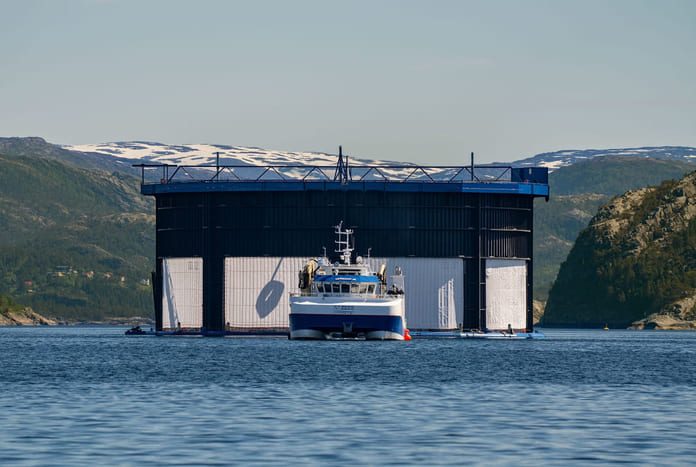Revolutionary water replacement.
Midt-Norsk Havbruk and Seafarming Systems are now in their fourth and final phase for Aquatraz. The fourth generation was designed to accommodate 3,000 tonnes of salmon, with a density of 50kg per m3. Originally, the fourth generation was to be contracted in December last year.
When SalmonBusiness met the project manager, high expectations were in the air on the pier in Rørvik, Central Norway.
The developer of the concept, Seafarming Systems, is now testing out a completely revolutionary way to change water.
“Coronavirus has caused delays, but we have made major changes to the design, based on learning. This has also led to a longer period of time,” said Steingrim Holm, project manager at Midt-Norsk Havbruk.

The Aquatraz cage currently has four power setters that put the water into circulation. It has two purposes. Circular flow of water, allowing the fish to be primed for better fish health, as well as to change enormous amounts of water.
Water replacement
“It is difficult to calculate in advance. We did many and advanced CFD (Computational Fluid Dynamics) calculations without fish. The calculations for water replacement matched the measurements we have made in full-scale trials,” said Holm.
“We saw that when there is a lot of salmon in the cage, we did not get the water replacement we want. We’re getting more recirculation. We have seen and made measurements that show a big difference in circular water speed in the cage at different times of the day, depending on the activity of the fish. We’re working on that bit now, and we think we’ve found the solution to that. This is something we will now test about as part of the final phase now in August,” he said.
“Then we will rebuild the third generation into a fourth, to test a new principle for replacing the water. The principle is patent-pending, so not much detail can be given, but if we succeed in this, it is a revolutionary way of thinking about water replacement,” Steingrim Holm told SalmonBusiness.

“We have thought a lot about how to ensure good water replacement with large biomass. We get answers to this very quickly. Testing will take place one month with biomass. It is only a matter of a few days after we have put fish out, before we see if the principle and the new solution work,” said Holm.
A patent has been sought by Seafarming Systems, which owns the technology. The idea behind the principle is that Alf Reidar Sandstad is behind it.

“With it, the Gordian knot can be fixed. It’s a completely different way of thinking. If we succeed, it is good for the fish, the farmer and the developer,” said Holm.
The term “Gordian knot,” is used to describe a complex or unsolvable problem, can be traced back to a legendary chapter in the life of Alexander the Great.
“This is a whole new way of thinking. We now have the opportunity to test this out. It will affect how the commercial cage is going to be. If the principle works, it will probably be the solution that goes ahead in a commercial phase for Aquatraz. We want to rebuild the cages we already have on the same principle. This is not the huge extra cost,” said Steingrim Holm.
In September, they will consider that the principle to be used for water replacement in the Aquatraz cages has been clarified. The investment in Aquatraz for MNH’s part will end in about EUR 35 million.

Good compared to lice
According to the company, the water replacement has worked well with eight-metre lice skirts. With 18m deep lice skirts, on the third generation, they have faced challenges with their replacement, when the biomass exceeded 900–1,000 tonnes.
“We see that the difference in oxygen saturation for flowing water and water in the cage is too large. The currents we have are not powerful enough when the biomass comes over well,” said Holm.
“We have had about 1,400 tonnes, with a density of 30 kilograms per m3 in Aquatraz cages on Kyrøyan. These cages had a lice skirt down to eight meters. It was too small to shield from lice at this area, was our experience. We have an exemption for a density of 45 kilograms per cubic meter, which corresponds to about 2,000 in the cages,” he said.

Lice skirt of 25m
“A lot of work has been done against the last generation, and we see that Aquatraz works well in relation to lice. Now we have shielding down to 18m, and have significantly less markup of lice. If it is shielded down to 25 meters, we will be able to protect ourselves very well from the lice,” said Holm.
“The fish are doing well, low mortality, fish health and welfare are good. What has been the biggest challenge so far has been to ensure sufficient water replacement to the large biomass when the depth of the lice skirt is increased to 20–25m. That’s what we’re focusing on solving right now,” he added.
Will review special licence
Norway’s Minister of Fisheries has announced a thorough review of various special licences in the aquaculture industry, in connection with the Government’s aquaculture strategy, which was launched last week.
“Development licences are a fantastic opportunity for fish farmers and developers of technology for the aquaculture industry. We see this through the project we have been working on,” said Holm.
“The project has been planned for a step-by-step development, where in the first two phases we have focused on making the technology work while for the last phases we have had the main focus on optimizing conditions for salmon with regard to fish health, fish welfare and production. With each phase we have learned a lot and these experiences we have brought with us in the design of the next generation,” he added.
“The key to profitability in this lies in good fish health and welfare, with a good water flow, which is good enough for large biomass. The project was planned to have a biomass of up to 3,000 tonnes in the fourth generation Aquatraz cage,” he said.

Development licences important
“Of course we have challenges that we have to solve. We must have licences to create development in the future. It will be beneficial. Whether it’s in the same shape as last time, or something else is going to be unseen from me. The scheme must stimulate development. We need it in addition to clean research permits. They often take much longer and are needed to obtain knowledge that benefits the entire industry and society,” said Holm.
“At least we see for our project what it has generated from learning and that benefits the entire industry in the form of, among other things, a cage design that can help solve the challenges of lice, while at the same time having a significantly better escape safety. There is a tremendous drive in the industry to develop new technology, it has not come without such permits,” said Holm.

Holm comes from 25 years in the oil and maritime industry. The shipping industry and offshore structures gave Holm the responsibility as project manager at MNH. That knowledge lead to Aquatraz.
Short distance to decision
“The interaction with Seafarming Systems has been very good. It’s like we worked in the same company. The advantage of a small organization is that we have been close and that it is effective. There is a short distance from idea to decision and execution. Then we have dragged with us external ones, including in biology from the very beginning,” said Holm.
“That’s what’s funny. The interaction between technology and biology. When working with ships, oil and gas, it is the physical laws that apply. When working with fish cages, you have to deal with living beings, the fish, and it also has its own psyche and shoal behavior, so it adds an extra dimension,” laughed Holm.
“If everything goes as we hope, we will have completed the entire project by the end of the year. Then it will be time for commercial operation, based on the learning now in the last phase. The results of the test, now in August, will determine what the commercial solution will be like. For us in Midt-Norsk Havbruk, it will nevertheless be considered a success,” Steingrim Holm concluded.




